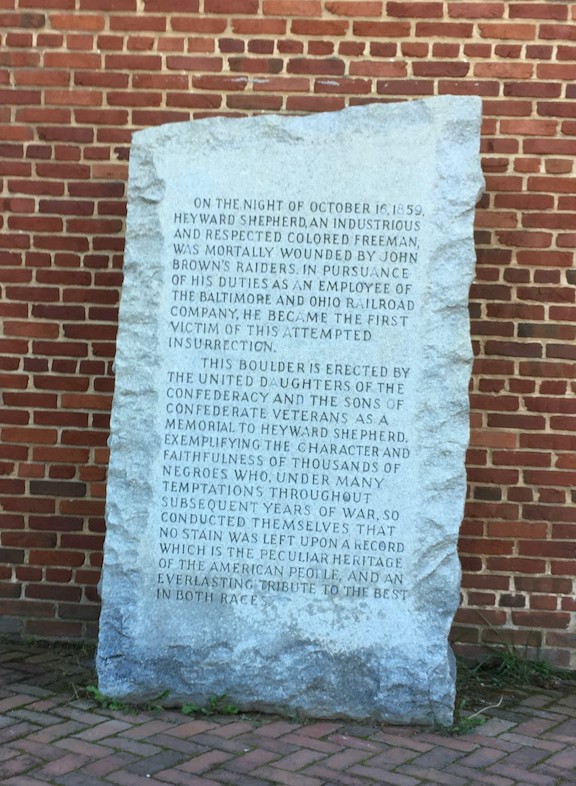Heyward Shepherd Memorialized (Sort Of)

On one hand, it’s fitting that a monument commemorates Heywood Shepherd. A night watchman at Harpers Ferry, Shepherd stumbled across John Brown’s raiders on the night of October 16, 1859. They called to Shepherd to surrender, but he refused, and the raiders shot him down. Civilian casualties like Shepherd don’t often get the attention they deserve, and so the marker provides some measure of recognition to an unfortunate innocent bystander whom history might otherwise have forgotten.
On closer inspection of the monument, though, it becomes apparent that Shepherd’s is not the only story this marker recounts. Erected with much controversy in 1931 by the United Daughters of the Confederacy and the Sons of Confederate Veterans, the monument has a more insidious story chiseled into its granite.

The Shepherd marker sits along the north side of the John Brown Museum, tucked right up against the museum’s wall. It faces cobblestoned Potomac Street and the former railroad bed, which puts it in a fairly high-traffic area as people come down from the train station and its adjacent parking lot, past shops and eateries, toward the historic district.
Heyward Shepherd was a free black man, reported to be a former slave, although the accuracy of that came into debate when the monument went up. What mattered to the UDC and SCV at the time was that John Brown’s raid, intended to help blacks, cost this particular black man his life. (Another black man, Dangerfield Newby, a member of Brown’s party, would also die in the raid.)
Reaction in the south to Brown’s raid, as you can imagine, was overwhelmingly negative in 1859. That perception didn’t much change by 1931. Eager to discredit Brown, the Confederate heritage groups installed the monument as a way to undermine any moral standing Brown’s subsequent admirers might have tried to argue.
In fact, the UDC had a Faithful Slave Memorial Committee, which reinforced an important thread of the overall Lost Cause narrative. The Shepherd monument reads like a page taken from that larger story. It refers to Shepherd as “an industrious and respected colored freeman” who was “mortally wounded…in pursuance of his duties….”
The UDC and SCV’s monument serves as memorial to Shepherd who, it says, “exemplified the character and faithfulness of thousands of negroes who, under many temptations throughout subsequent years of war, so conducted themselves that no stain was left upon a record which is the peculiar heritage of the American people, and an everlasting tribute to the best in both races.”
I admit, that purple prose always leaves me scratching my head. And, oh, the things that florid language doesn’t say.
As I said, the plight of civilians often gets overlooked in military matters, so I’m glad Shepherd’s story gets some attention. But like any memorialization, this monument preserves a particular memory with a particular slant. In our modern era of “fake news” (or fake “ fake news,” as the case might be), it’s more important than ever that we all be discerning consumers of information. The Shepherd monument provides an excellent reminder.
There are published Civil War histories from the 19th Century that are uncomfortable to read, due to the fact they make use of terminology that society deems no longer appropriate. References to former slaves, German immigrants, Hungarian immigrants, Native Americans and “the Irish” all fall into this category. Yet, we all persist with reading those references because the alternative (burning them) is even more distasteful.
The same with the Heyward Shepherd Memorial. It was erected at a time when attitudes were different, and those attitudes were reflected in the language. And the Memorial indicates how far we have come in addressing Equal Rights and societal norms. My recommendation would be to copy this well written ECW article by Chris Mackowski and present it as a New Memorial to Heyward Shepherd, on condition it be erected alongside the existing stone monument.
Thanks for the kind words, Mike.
By the way, I would not advocate taking down the current Shepherd monument (not that you were suggesting I was suggesting it). This is a great example of an instance where some contextualization would work really well instead of removal.
“Faithful Slave Memorial Committee” just about says it all.
Brown intended to start a rebellion by enslaved people in which hundreds, if not thousands, of lives of people of both races would have been lost. The refusal of African Americans to resort to such a slaughter is worthy of commendation. The monument in question does just that, I know of no other which does. Instead of questioning the integrity of those who placed this monument ask why no other groups have had the interest or motivation to comment the patience and forbearance of an abused people.
Except that the people who erected the monument were descendants of people who DID start a rebellion in which hundreds of thousands of lives of people of both races were lost, so on some level, there was a little “smoke and mirrors” going on.
Mind you, I’m not condemning the UDC or SCV for erecting the monument, just trying to parse out the stories the monuments trying to explicitly and subtly tell.
It is interesting how Brown is viewed throughout history. He epitomizes the adage that “You either loved him or hated him”. He flat-out murdered in the name of his cause. And as the article points out, among those who died at his hands were some of the very ones they were fighting for. I think because of that he discredited his own efforts.
The monument doesn’t state anything that in may cases was true. History is often an uncomfortable companion.
It is said that history is written by the winners. But here we see counter proof of that.